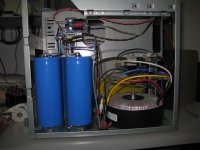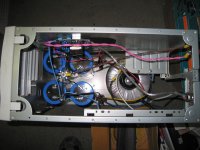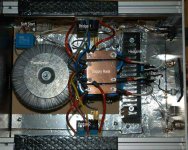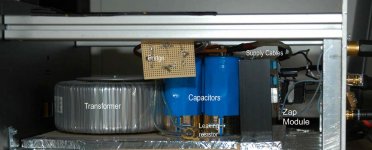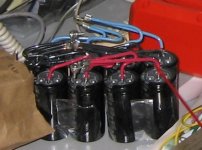I'm just trying not to force feed people, as I know it's annoying.
That depends heavily on the taste of the food.
$200 - $300
At the current exchange-rate for the USD this would be an interesting price for 2 channels + PSU + signal processing (can you implement transient-perfect crossovers as well ?).
It's not trademarked in the UK and I haven't had a writ from Mr Gates.
I assume he would actually be pleased if you caused confusion with the other ".....-pod".
Regards
Charles
Hi Davey
Yes, that could be one solution. But there would also be possibilities for transient perfect IIR filters.
A possible candidate is a proposal by John Kreskovsky (a sporadic poster on this forum). He subtracts a lowpass with constant group delay (i.e. Bessel) from a constant delay (i.e. a simple circular buffer) to obtain the highpass. The summed response is exactly representing the input in time- and frequency- domain.
The advantage over a FIR crossover is that it doesn't have pre-ringing. The disadvantage is its asymmetric slopes.
Regards
Charles
Yes, that could be one solution. But there would also be possibilities for transient perfect IIR filters.
A possible candidate is a proposal by John Kreskovsky (a sporadic poster on this forum). He subtracts a lowpass with constant group delay (i.e. Bessel) from a constant delay (i.e. a simple circular buffer) to obtain the highpass. The summed response is exactly representing the input in time- and frequency- domain.
The advantage over a FIR crossover is that it doesn't have pre-ringing. The disadvantage is its asymmetric slopes.
Regards
Charles
Re: Re: Best Sounding Class D Amp
Another newbie to this forum. I read the info on the LC Audio website and it seems reasonably easy for someone slightly hamfisted (myself) to build a working amplifier. Add a decent sized transformer.....
But the real question is, how good is the sound from the ZAPPulse? I don't have any unused >1KVA traffos on the shelf so every nut and bolt has to be purchased for this project. Therefore I would like to know what to expect. The last sentence should read: what you found when you built your amplifier. Sound quality is a very subjective thing, but how does it compare to commercially available amplifiers? In round figures I reckon on a spend of €750.00 so is it reasonable to compare a self built amplifer with a commercially built unit retailing at €1.5K? Thanks for taking the time to read this post, hope my query makes sense.
sven-ake said:Zappulse from LC Audio should be something to try you can build them very powerful if you like.I have mine driving martin Logan SL3 and it works really good and they are very easy to build.With the PSU i use they can deliver approx.700w in 4 ohms
Another newbie to this forum. I read the info on the LC Audio website and it seems reasonably easy for someone slightly hamfisted (myself) to build a working amplifier. Add a decent sized transformer.....
But the real question is, how good is the sound from the ZAPPulse? I don't have any unused >1KVA traffos on the shelf so every nut and bolt has to be purchased for this project. Therefore I would like to know what to expect. The last sentence should read: what you found when you built your amplifier. Sound quality is a very subjective thing, but how does it compare to commercially available amplifiers? In round figures I reckon on a spend of €750.00 so is it reasonable to compare a self built amplifer with a commercially built unit retailing at €1.5K? Thanks for taking the time to read this post, hope my query makes sense.
Hi,
The zappulse 2.2 SE is a very good sounding module but I think this strongly depends on the speaker you want to drive with it. The experiences with speaker with complex impedances are not so good aparantly. Low impedance is no problem at all the modules can deliver lot's of current
I've had experience with Zap and Ice and the Zap sounds better than Ice IMHO, and the zap also sounds better than a Krell KSA 100 MK2. They outperformed the Rotel RB980BX by a very large margin.
I never heard the UCD modules.
The zappulse 2.2 SE is a very good sounding module but I think this strongly depends on the speaker you want to drive with it. The experiences with speaker with complex impedances are not so good aparantly. Low impedance is no problem at all the modules can deliver lot's of current
I've had experience with Zap and Ice and the Zap sounds better than Ice IMHO, and the zap also sounds better than a Krell KSA 100 MK2. They outperformed the Rotel RB980BX by a very large margin.
I never heard the UCD modules.
zappulse drive capability
Eric's answer is similar to my experiences- I have M-L Ascents [v. difficult load], and with the PSU on the upper end of the recommended voltage rail I had some early rolloff of LF. This was not the case with the UCD modules.
I saw mentioned in the forum recently that you reduce the output impedance of the Zaps by lowering their rail volts, so that's next to try.
Eric's answer is similar to my experiences- I have M-L Ascents [v. difficult load], and with the PSU on the upper end of the recommended voltage rail I had some early rolloff of LF. This was not the case with the UCD modules.
I saw mentioned in the forum recently that you reduce the output impedance of the Zaps by lowering their rail volts, so that's next to try.
I've experimented a bit with 2.2SE Zappulse and have found it to sound very good with a beefy power supply. I have a pair of Watt/Puppy 6s and my normal amp is a Threshold S/500 II which I've been very happy with over the years. My comments below are in comparison to the Threshold.
I tried LC Audio's Predator power supply with two modules side by side, and found the channel separation to be poor, the bass had an initial impact but no body, and a rather closed in sound like the high frequencies were rolled off.
Then I tried paralleling some big capacitors (84,000uf) with the Predator power supply. This dramatically improved the bass and suprisingly enough helped the highs quite a bit as well. The channel separation was still bad and the highs still sounded rolled off, but not as bad as before.
So I decided to try a totally maxed out power supply with separate monoblocks. Each amp has a 1500VA transformer with 328,000uf of capacitors with bridge rectifiers and some bypass capacitors. With this combination, the amp was finally a contender; separation was excellent (as you would expect), the impact, dynamics, and control were outstanding and superior to the Threshold. The sound is very clean with excellent clarity and a great soundstage, but the highs still seem a bit rolled off; there's not the same airy spaciousness to the sound I get with the Threshold. Also, at medium to high volume levels the midrange gets a recessed sound, almost like it's at the end of a long tube, kind of a weird effect that is hard to describe.
I plan on trying a little RC snubber on the main caps with a 100uf cap attached directly to the modules like the chip amp folks have been discussing to see if this will make any difference to the sound. Also, I really want to try some of the UCD modules when they start making them again; hopefully they'll do the nice things the Zaps do without the odd things.
In summary, there's a number of things I like about the Zappulse amps better than the Threshold including having a generally clearer and less distorted sound, but the weird recessed sound effect and the less open sounding top end have me sticking with the Threshold. But they sound better than a couple of other amps I've tried in my system, an Adcom GFA-555 and a Cary Audio CAD572SE, and I think better than many other amps that I've tried in other systems over the years.
Just my observations and opinions. YMMV!
I tried LC Audio's Predator power supply with two modules side by side, and found the channel separation to be poor, the bass had an initial impact but no body, and a rather closed in sound like the high frequencies were rolled off.
Then I tried paralleling some big capacitors (84,000uf) with the Predator power supply. This dramatically improved the bass and suprisingly enough helped the highs quite a bit as well. The channel separation was still bad and the highs still sounded rolled off, but not as bad as before.
So I decided to try a totally maxed out power supply with separate monoblocks. Each amp has a 1500VA transformer with 328,000uf of capacitors with bridge rectifiers and some bypass capacitors. With this combination, the amp was finally a contender; separation was excellent (as you would expect), the impact, dynamics, and control were outstanding and superior to the Threshold. The sound is very clean with excellent clarity and a great soundstage, but the highs still seem a bit rolled off; there's not the same airy spaciousness to the sound I get with the Threshold. Also, at medium to high volume levels the midrange gets a recessed sound, almost like it's at the end of a long tube, kind of a weird effect that is hard to describe.
I plan on trying a little RC snubber on the main caps with a 100uf cap attached directly to the modules like the chip amp folks have been discussing to see if this will make any difference to the sound. Also, I really want to try some of the UCD modules when they start making them again; hopefully they'll do the nice things the Zaps do without the odd things.
In summary, there's a number of things I like about the Zappulse amps better than the Threshold including having a generally clearer and less distorted sound, but the weird recessed sound effect and the less open sounding top end have me sticking with the Threshold. But they sound better than a couple of other amps I've tried in my system, an Adcom GFA-555 and a Cary Audio CAD572SE, and I think better than many other amps that I've tried in other systems over the years.
Just my observations and opinions. YMMV!
Greg, thanks for your informative comment. Interesting how that particular amp came together for you using the mondo-supply approach. I wonder if a judicious use of film capacitors might help in the airiness department? But might also augment certain of the weird effects of which you speak?
Cheers.
Cheers.
I'm planning to try the snubber circuit that has been discussed on the chip amps forum in this thread http://www.diyaudio.com/forums/showthread.php?s=&threadid=48942serengetiplains said:Greg, thanks for your informative comment. Interesting how that particular amp came together for you using the mondo-supply approach. I wonder if a judicious use of film capacitors might help in the airiness department? But might also augment certain of the weird effects of which you speak?
Cheers.
I'm hoping this will help the airiness, but will be surprised if it ameliorates the weird effects I noticed, but keeping my fingers crossed. It's a little frustrating because on some pieces of music, the amps sounded absolutely killer with a tubelike midrange, clean elegant highs, and a tight, deep, effortless bass that would put a Krell to shame. But then other times they would just sound kind of dead and a little like they were in a cave. They didn't sound BAD when this happened, just not GOOD, and often just on certain parts of a piece of music.

I had them in my system for a little over a week, and never felt a need to pull them out which is a good sign. When I went back to the Threshold I immediately noticed a more distorted and hashy sounding high end and relatively loose control of the bass, but despite that, it had a lifelike quality to it that the Zappulse couldn't match, and the sound is always consistent, at least after a 15 to 20 minute warm up period. The Zappulse based amp changed it's sound quite a bit for the better in the first hour or so of operation. After that, I didn't notice much difference.
A couple of other notes. The Zappulse had more hiss from the tweeters than the Threshold without music. I could hear the Zappulse from about 2 to 3 feet away, the Threshold only inside of 6 inches. I don't think it's too meaningful since both sound silent from my listening position. Also, something I had never checked before, the Threshold puts out a very low level 60HZ hum when I practically stuck my head in the midwoofer, no hum at all from the Zaps.
Here's a picture from the top of the amp. I like the way the star ground ended up looking like a star.

Attachments
Here are my mono blocks
This was originally replied to a question I got per email but I share it with anyone wo is interested:
I will first explain what steps I went trough, what the final result is , and tell you what I would use when I built it again.
At first I tried to build one stereo amplifier. That amplifier was built with the follwing power supply module:
BMM 90V
Also one 625 watt / 2*55VAC torroid transformer was used in this stereo amp
This did not sound good at al, lack of real bass and grainy mid and highs! I went listening to someone else his monoblocks and they were much better. So I decided to build something similar but improved the power supply according the zero distortion article.
The new transformers (2* 40VA / 1000VAC) arrived before the rest of the components so I tried one of this transformers in the stereo amp, and immediately the sound was very good.
I'm pretty sure you should keep the voltage around the 40 Volt even if the specifications of the Zap module alow more. I also believe: the bigger the transformer; the better the sound.
So I built my mono-blocks using the following components per channel:
*) 1000 VA / 2*40 VAC torroid (Even bigger is probably better but these are still standard size and relative cheap. (under 80 euro at www.Farnell.com )
*) 4* 33000uF BC components, 63V Capacitors. (so that is 132.000uF per channel, maybe less is possible but I wanted to be sure everything was perfect.)
I got them at Schuro for reasonable prices: BC 154 series
*) 8 Hi speed diodes ( Schuro ) You can built a single bridge with 4 diodes but the zero distortion document recommended double bridges to separate the power supply physically from the mains. I used this for the Zappulse module to prevent the ground loop related high frequency noise from occurring) If I built new ones I would probably use normal square rectifier bridges (but always double bridge). Aparantly there is an article from Nelson Pass somewhere that explains that these are better for Power amplifiers and they are a lot cheaper and makes it easier to built as well. You can get them everywhere.
*) All smaller capacitors as indicated in the zero distortion document, they are relative cheap.
*) 2 pcs of 25Watt 6k8 leak resistors over the power supply rails.
*) a softstart circuit ( I used this one ) I needed to change the timing because the standard values were too small for this size power supply.
I made 3 solid copper plates for the supply rails.
Signal cabling is all solid core silver in teflon tubing.
Connectors are WBT for Speaker and Chinch and Neutrik for XLR.
There a 5 things thing I could improve:
1) Even a bigger transformer
2) Shorter cables between zap module and power supply, layout needs to be different especially the heatsink location.
3) RF filters on the mains connection
4) The normal rectifier bridges to get rid of the chaotic cabling around the self made bridges.
5) Fully aluminum casing, It currently has a MDF bottom. As you see I put some aluminum tape on this, I did that when I had some noise problems with one amplifier. It turned out that one of the soldering joints was loose but I thought it had to do with the wooden part of the casing.
Please keep in mind that I have Apogee speakers that are very low impedance and pull a lot of current out of the amplifier. You might be satisfied with a lot smaller power supply.
This was originally replied to a question I got per email but I share it with anyone wo is interested:
I will first explain what steps I went trough, what the final result is , and tell you what I would use when I built it again.
At first I tried to build one stereo amplifier. That amplifier was built with the follwing power supply module:
BMM 90V
Also one 625 watt / 2*55VAC torroid transformer was used in this stereo amp
This did not sound good at al, lack of real bass and grainy mid and highs! I went listening to someone else his monoblocks and they were much better. So I decided to build something similar but improved the power supply according the zero distortion article.
The new transformers (2* 40VA / 1000VAC) arrived before the rest of the components so I tried one of this transformers in the stereo amp, and immediately the sound was very good.
I'm pretty sure you should keep the voltage around the 40 Volt even if the specifications of the Zap module alow more. I also believe: the bigger the transformer; the better the sound.
So I built my mono-blocks using the following components per channel:
*) 1000 VA / 2*40 VAC torroid (Even bigger is probably better but these are still standard size and relative cheap. (under 80 euro at www.Farnell.com )
*) 4* 33000uF BC components, 63V Capacitors. (so that is 132.000uF per channel, maybe less is possible but I wanted to be sure everything was perfect.)
I got them at Schuro for reasonable prices: BC 154 series
*) 8 Hi speed diodes ( Schuro ) You can built a single bridge with 4 diodes but the zero distortion document recommended double bridges to separate the power supply physically from the mains. I used this for the Zappulse module to prevent the ground loop related high frequency noise from occurring) If I built new ones I would probably use normal square rectifier bridges (but always double bridge). Aparantly there is an article from Nelson Pass somewhere that explains that these are better for Power amplifiers and they are a lot cheaper and makes it easier to built as well. You can get them everywhere.
*) All smaller capacitors as indicated in the zero distortion document, they are relative cheap.
*) 2 pcs of 25Watt 6k8 leak resistors over the power supply rails.
*) a softstart circuit ( I used this one ) I needed to change the timing because the standard values were too small for this size power supply.
I made 3 solid copper plates for the supply rails.
Signal cabling is all solid core silver in teflon tubing.
Connectors are WBT for Speaker and Chinch and Neutrik for XLR.
There a 5 things thing I could improve:
1) Even a bigger transformer
2) Shorter cables between zap module and power supply, layout needs to be different especially the heatsink location.
3) RF filters on the mains connection
4) The normal rectifier bridges to get rid of the chaotic cabling around the self made bridges.
5) Fully aluminum casing, It currently has a MDF bottom. As you see I put some aluminum tape on this, I did that when I had some noise problems with one amplifier. It turned out that one of the soldering joints was loose but I thought it had to do with the wooden part of the casing.
Please keep in mind that I have Apogee speakers that are very low impedance and pull a lot of current out of the amplifier. You might be satisfied with a lot smaller power supply.
Attachments
This is a side view of the same mono, as you can see construction wise it is what you could call "proper DIY"
I skipped on using any high quality bypass capacitors because the Zap 2.2SE module takes care of that with it's Blackgate's mounted directly on the module.
I skipped on using any high quality bypass capacitors because the Zap 2.2SE module takes care of that with it's Blackgate's mounted directly on the module.
Attachments
[
Greg, the modules on your pictures don't look like the 2.2SE modules. The SE version has 2 rubycon black gate capacitors on the module. I see only 2 blue elco's on your pictures.
Also the size of my transformers appears to be similar to yours (even bigger, they wouldn't fit in a pc mini tower width wise) but you claim yours is 1500VA and mine are 1000VA???
My modules are very consistent and no sign of harschness. I also cannot hear any hiss at all even if I put my ear on the speakers.
What's the voltage on the supply rails you got?
do you got mains filtering installed? If not the sound quality could vary depending on what else is happening on your mains net.
GregD said:I've experimented a bit with 2.2SE Zappulse and have found it to sound very good with a beefy power supply. ..........
Greg, the modules on your pictures don't look like the 2.2SE modules. The SE version has 2 rubycon black gate capacitors on the module. I see only 2 blue elco's on your pictures.
Also the size of my transformers appears to be similar to yours (even bigger, they wouldn't fit in a pc mini tower width wise) but you claim yours is 1500VA and mine are 1000VA???
My modules are very consistent and no sign of harschness. I also cannot hear any hiss at all even if I put my ear on the speakers.
What's the voltage on the supply rails you got?
do you got mains filtering installed? If not the sound quality could vary depending on what else is happening on your mains net.
ericpeters said:[
Greg, the modules on your pictures don't look like the 2.2SE modules. The SE version has 2 rubycon black gate capacitors on the module. I see only 2 blue elco's on your pictures.
--snip--
The BG caps where replaced a while back.
Guys, many many thanks for all the replies. Those are seriously large caps!!!!! My speakers are (oldish) Ruark Crusader 2 which are I think nowhere as severe a load as some speakers, I think I will dip my toes into the water by building a stereo amplifier with a traffo greater than 1 KVA and see how it sounds. Better than a Krell???, that is saying something!!
Can't wait to hear it speak.
Can't wait to hear it speak.
I ordered the SE modules and that's what it showed on the invoice, and my modules match the pictures on LC Audio's website http://www.lcaudio.com/index.php?page=35 I remember when I ordered them reading that they had recently changed the capacitors on the modules, so I assume that's where the difference in appearance lies.ericpeters said:[
Greg, the modules on your pictures don't look like the 2.2SE modules. The SE version has 2 rubycon black gate capacitors on the module. I see only 2 blue elco's on your pictures.
Also the size of my transformers appears to be similar to yours (even bigger, they wouldn't fit in a pc mini tower width wise) but you claim yours is 1500VA and mine are 1000VA???
My modules are very consistent and no sign of harschness. I also cannot hear any hiss at all even if I put my ear on the speakers.
What's the voltage on the supply rails you got?
do you got mains filtering installed? If not the sound quality could vary depending on what else is happening on your mains net.
The case is actually a medium tower, the transformers are 8" in diameter and about 4" tall with dual 45V secondaries, seems about right for 1500VA. I'm getting +/-60V on the rails with dual bridge rectifiers. I have a Schaffner mains filter integral with the IEC socket, and a soft start circuit of course. The big electrolytics are United Chemicon 100V 82,000uf each U32D series. I assume that the zero distortion PSU you're talking about is here http://www.zero-distortion.com/start.htm Did you try your amp without the small capacitors?
I also have heard no sign of harshness, just the strange recessed sound effect I mentioned earlier at medium and higher volume levels. I'm not surprised you don't hear the hiss with your speakers since the sound is spread over the whole surface of the ribbon. By the time you get far enough back from the speaker to be getting the sound from a significant portion of the ribbon, the level will be too low to hear; it's not a point source tweeter like my speakers.
Which Apogees do you have? I have a pair of Divas in storage; they wouldn't fit into my new place when I moved.

Re: Here are my mono blocks
I like your amp construction; it looks and sounds like excellent quality. One thing I was wondering about though was your leakdown resistors, "2 pcs of 25Watt 6k8 leak resistors over the power supply rails". With the 40V transformer, I assume that your output rails are about 55V. Watts = 55 * 55 / 6800 = .44 watts, so why 25 watt resistors? I have 3k6 2 watt leakdown resistors on mine, and with the big capacitors it takes a long time for the voltage to come down to safe levels; the amp will play at a medium to high volume level for over a minute after it's unplugged.
I like your amp construction; it looks and sounds like excellent quality. One thing I was wondering about though was your leakdown resistors, "2 pcs of 25Watt 6k8 leak resistors over the power supply rails". With the 40V transformer, I assume that your output rails are about 55V. Watts = 55 * 55 / 6800 = .44 watts, so why 25 watt resistors? I have 3k6 2 watt leakdown resistors on mine, and with the big capacitors it takes a long time for the voltage to come down to safe levels; the amp will play at a medium to high volume level for over a minute after it's unplugged.
sven-ake said:I was told by Henrik at LCaudio not to use more capacitors than max 30.000uf because they had experimented and found that the midrange suffered when they used bigger caps.As i see you DIY:ers testing bigger ones and with good results i begin to wonder a lot.
When I have a little time, I'm going to try some smaller caps while leaving the rest of the power supply the same. I plan to try 20,000uf per rail, and 40,000uf per rail using these.
Attachments
- Status
- This old topic is closed. If you want to reopen this topic, contact a moderator using the "Report Post" button.
- Home
- Amplifiers
- Class D
- Best Sounding Class D Amp

